If you own an e-commerce website or are interested in online sales, you must grow your e-commerce business. This post provides a lot of information. These statistics alone are proof. You need to beef up your e-commerce website.
In this post, I will help you understand the online consumer shopping trends based on my research and the most prominent companies in the e-commerce space.
In addition, I explain the tools they use and provide tips on how to strengthen your e-commerce web business. It’s a lot of information, but I think it’s worth looking over!
We’re concerned about the economy’s potential direction, especially with tariffs, but there is no need to panic. Instead, take action and continue improving your website. I hope this post helps you!
The article is about a 13-minute read. I have placed a directory below so you can scan topics that may interest you.
Directory
Description list: (tap the numbered item to go down to the subject title)
Understand Online Sales and the Changing Consumer Habits
The paradigm shift…
How we adapt and how things change. I’m sure you remember (the 2020-2021 years of the COVID pandemic) that many stores placed online pickup counters up front. And the addition of outside pickup areas. Best Buy probably mastered the curbside pickup. And all the major chains have in-store pickup now.
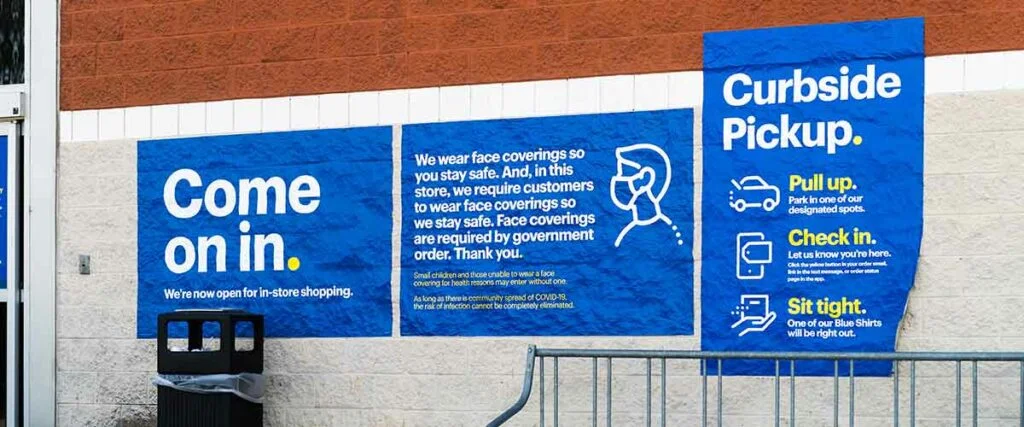
The COVID-19 Pandemic was a Huge Boon for Online Shopping Websites
Why 2021 was a boom for online sales—
- Most Americans were on lockdown, not as restrictive as China’s situation, but still scary enough to keep people home.
- The people who could work from home gained both free time and personal savings.
- There was a significant shift in consumer spending from services to goods for these housebound shoppers.
- The financial stimulus payments reached three-quarters of American households from Uncle Sam.
The pandemic fundamentally altered consumer habits in ways that persist today—large retailers must adapt their strategies to these enduring behavioral changes.
Looking to grow your online sales?
Fourth quarter 2024 U.S. E-Commerce Retail Sales
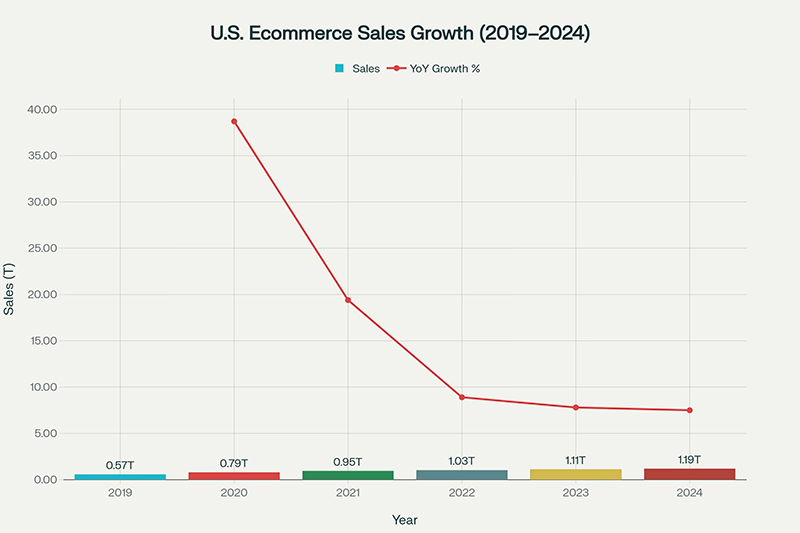
U.S. e-commerce retail sales for the last twelve months (LTM) reached approximately $1.19 trillion. For just the fourth quarter, e-commerce sales were estimated at $352.9 billion, a record high for quarterly online retail. This LTM figure represents an 8.1% increase from 2023123.
- E-commerce made up 16.1% of all U.S. retail sales for the full year 2024.
- For Q4 alone, e-commerce penetration hit even higher at 17.9–24.6% of total retail sales, depending on the reporting method.
This reflects ongoing strength in online retail—particularly during the holiday season, which accounted for over $240 billion in November and December alone—while annualized sales continued to outpace total retail sales growth by a wide margin. 412.
Why did Q4 2024 e-commerce sales hit a record high?
U.S. e-commerce sales hit a record high in Q4 2024 due to a combination of strong holiday demand, a continued shift in consumer behavior toward online shopping, and the increasing role of mobile commerce and digital marketing.
Key reasons include:
- Holiday Shopping Surge: The holiday season, particularly November and December, remains the peak period for online retail. In Q4 2024, over $240 billion in e-commerce sales occurred during the holiday season, with major milestones like Black Friday and Cyber Monday (the “Cyber 5”) accounting for more than $41 billion in just five days1.
- Mobile Shopping Boom: A growing share of holiday and Q4 sales came from smartphones—54.5% of online holiday purchases were made on mobile devices. The ease and prevalence of mobile shopping, paired with optimized user experiences, significantly boosted overall sales15.
- Persistent Consumer Shift to Online: Even after pandemic-era disruptions settled, consumers continued to favor digital channels. Q4 2024 marked the tenth consecutive quarter where e-commerce growth outpaced total U.S. retail growth, reflecting an ongoing structural shift from offline to online shopping125.
- Early and More Distributed Holiday Spending: Shoppers began purchasing earlier in the season, not just during the traditional late-December rush, with seasonal events and promotions like Amazon Prime Day and “Turkey 5” also contributing to high traffic and sales well before year-end6.
- Technological Improvements & Personalization: Broader adoption of AI-driven marketing and personalized shopping experiences helped retailers target consumers more effectively, driving higher conversion rates and repeat purchases45.
- Strong Category Performance: Sectors such as clothing, accessories, and general merchandise posted double-digit increases over 2023, fueling total growth. Building materials and garden sectors also saw a rebound, reaching their own e-commerce records2.
Quantitative data for Q4 2024:
- E-commerce sales reached $352.9 billion, up 22.1% from Q3 and 9.3% year-over-year12.
- E-commerce accounted for 17.9–24.6% of all retail sales in Q4, its highest penetration on record12.
- For the year, total U.S. e-commerce sales hit approximately $1.19 trillion25.
Summary:
The record Q4 2024 e-commerce performance was driven by robust holiday demand, pervasive mobile use, earlier and more frequent seasonal promotions, and consumers’ enduring shift toward online and mobile-first shopping—all amplified by technology and personalized marketing12456.
What About Amazon?
The pandemic caused an online shopping boon exacerbated by stimulus checks, and Amazon was one of the benefactors. In mid-2021, Amazon reported $108.5 billion in sales in the first three months, up 44 percent from the year earlier!
Amazon remains a dominant force in retail sales, especially online, and continues to outpace both Walmart and Target in revenue growth as of 2024. Here’s how they stack up, with up-to-date statistics and a comparison chart:
2024 Revenue and Growth: Amazon, Walmart, Target

Amazon’s sales soared in the pandemic and continue to grow robustly, reaching $638B in 2024, up 11% from 2023.aboutamazon+3
Walmart remains the overall largest retailer by revenue, with $642.6B in 2024.analyzify+1
Target’s sales dipped slightly in 2024 after pandemic highs, with $106.6B in revenue, a decline of 0.8% from the previous year.
Amazon’s e-commerce business has been growing at about 15 percent a year. Walmart is up 21 percent, and Target grew its online sales by 23 percent.
Revenue Comparison Chart
Annual Revenue Comparison of Amazon, Walmart, and Target for 2023 and 2024 with Growth Percentage:
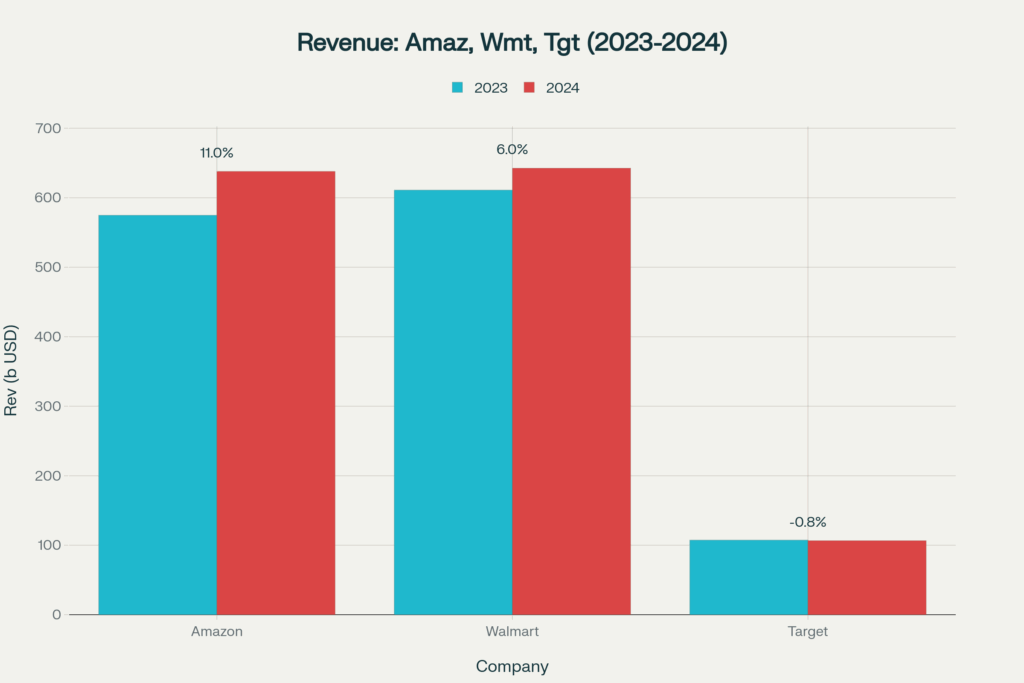
Key Insights
- Amazon’s online business leads digital growth and has, in some quarters, started to rival or exceed Walmart’s sales figures, especially in Q4 2024.forrester
- Walmart’s strength is in its massive store network but its digital surge (including e-commerce) remains a significant portion of its overall growth.analyzify+1
- Target’s growth has plateaued post-pandemic, with a slight downturn in total revenue, but it continues to perform well in categories like beauty and essentials.corporate.target+1

Like this blog post?
Are you interested in maximizing your online growth? We can help with Web Strategy, Web Design & Development, SEO, and content writing. Talk to Us! Call: (857)400-8959
Top 10 Shopping Websites Used By U.S. Shoppers for Second-Hand Product Search in 2025
- eBay
- Facebook Marketplace
- Poshmark
- Depop
- thredUP
- The RealReal
- Rebag
- Vestiaire Collective
- Swap
- Etsy (Vintage Section)
Market share estimates and ranking are based on an aggregation of industry reports and consumer usage surveys. eBay and Facebook Marketplace are the clear leaders, followed by Poshmark and Depop (especially popular for fashion), with specialized luxury and thrift platforms rounding out the top ten.
What Are Shoppers Buying Online?
Online shoppers buy Beauty & Personal Care, Clothing, and Books product categories. Groceries, Cleaning Supplies, and over-the-counter medicine are purchased more frequently in brick-and-mortar stores.
Online shoppers in the U.S. are primarily buying across these categories in 2024-2025:
- Electronics:
Including smartphones, computers, wearable tech, and home gadgets—expected sales around $922 billion globally, $219 billion in the U.S., making it the top revenue category. - Fashion and Apparel:
Clothing and accessories rank second, with U.S. sales near $203 billion. It’s the most frequently purchased category online. - Food and Groceries:
Online food shopping remains very popular with convenience-focused consumers; U.S. ecommerce food sales near $125 billion, growing rapidly. - Beverages:
Craft beers, premium coffees, and other specialty drinks drive this $248 billion global segment. - DIY, Hardware, and Home Improvement:
With $220 billion in U.S. In the DIY, Hardware, and Home Improvement category, more shoppers are purchasing tools, hardware, and home goods online. - Furniture and Home Furnishings:
Online furniture sales continue to grow, pushing $74 billion in the U.S. - Health, Beauty, and Personal Care:
Skincare, cosmetics, and supplements with revenues near $29 billion in the U.S. - Toys and Hobbies:
It is popular, especially with younger demographics and collectors. - Media (Books, Movies, Video Games):
Online purchases related to books and entertainment continue to be a robust category. - Luxury Goods:
High-end fashion, watches, and accessories.
United States: retail e-commerce projected revenue for 2017-2025


Published by Statista Research Department, Jan 3, 2022
Revenue from retail e-commerce in the United States was estimated at roughly 768 billion U.S. dollars in 2021. The Statista Digital Market Outlook forecasts that by 2025, online shopping revenue in the U.S. will exceed 1.3 trillion dollars.
Mobile commerce sales as a percentage of total retail sales in the United States from 2018 to 2025
Mobile commerce (m-commerce) has grown rapidly in the United States, now accounting for the clear majority of total retail e-commerce sales. Here are the annual percentages of mobile commerce sales as a share of total U.S. retail sales from 2018 to 2025:
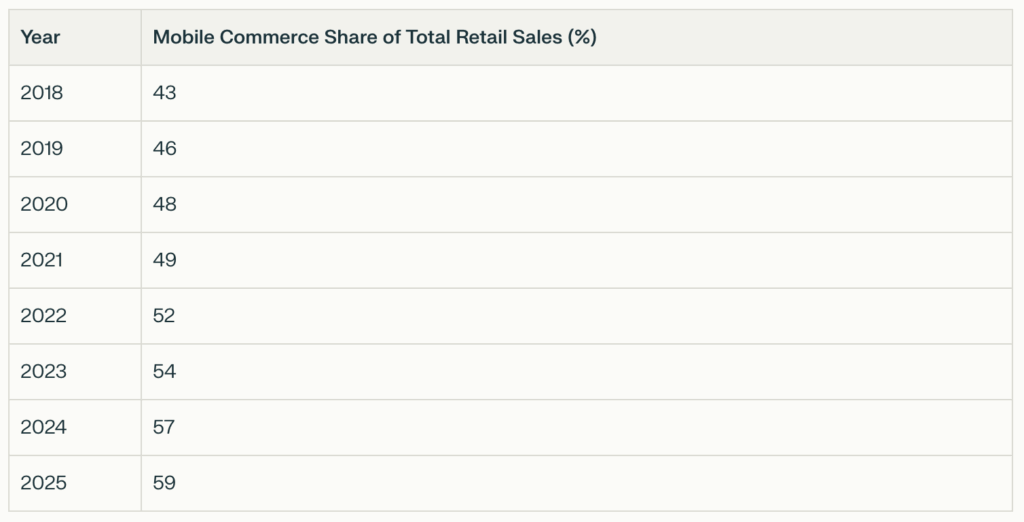

The percentage of retail sales occurring via mobile rose from 43% in 2018 to a projected 59% in 2025, illustrating the dominance of smartphones and tablets as shopping devices in the U.S. market.
The percentage of retail sales occurring via mobile rose from 43% in 2018 to a projected 59% in 2025, illustrating the dominance of smartphones and tablets as shopping devices in the U.S. market. This reflects not only a shift in consumer habits but also retailers’ improvements in mobile websites, apps, and shoppable social media.sellerscommerce+1
Mobile Commerce Sales as a Percentage of Total U.S. Retail Sales (2020-2025)
US mobile commerce sales have more than doubled since 2020, surging from about $322B to a forecasted $710B by 2025.
The highest single-year percentage growth was in 2023, with a 26.9% jump.
The trend reflects continued investment in mobile user experiences, app-based shopping, and mobile payment adoption.
US Mobile Commerce Sales and Year-Over-Year Growth, 2020-2025
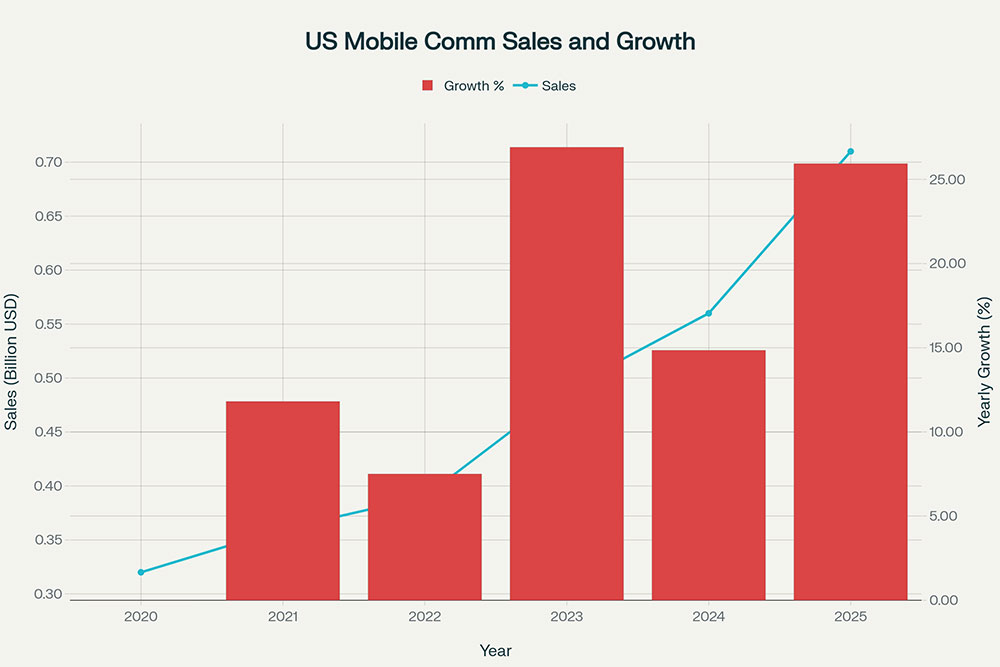

These figures show how mobile shopping has become central to US retail, carving out a share of both total e-commerce and overall retail sales. This rapid growth reflects evolving consumer habits and the rising influence of smartphones as primary shopping devices. It’s amazing seeing these numbers continue to grow.
FTI Consulting project U.S. online retail sales will surpass $2.0 trillion by 2030 (Exhibit 8), while total online market share will approach 31% by the end of the decade compared to 21% at the end of last year.
What is interesting is that the new shopping habits that we acquired during the pandemic are mostly sticking. Now evident since mid-2021 that the pandemic’s impact on online shopping wasn’t merely a one-time boom that will disappear with the virus.
Our clothing clients tell us that in-store visits are returning, and their online sales remain pretty strong. Shopping for clothes makes sense now since most of us are not going out, visiting venues, traveling, etc. Not to mention some of our clothes don’t fit quite right now.
As for myself, I continue to shop online, but I will visit my local small business for things I need. Supporting them is important to me.
As for business, we are a little more conscious of our expenses since many have increased. And the cost of gasoline hits home with traveling back and forth.




Like this blog post?
Are you interested in maximizing your online growth? We can help with Web Strategy, Web Design & Development, SEO, and content writing. Talk to Us! Call: (857)400-8959


12 Proven Ways to Increase E-Commerce Sales and Promote Your Online Store
Getting customers to purchase from your online store is challenging – especially for small business owners in a crowded marketplace. The web is saturated with shopping sites, which means you need to do more things right than wrong to stand out. It’s no longer a simple case of “build it and they will come.” Instead, you have to actively promote your online store and continually optimize your website to convert visitors into customers.
In this guide, we’ll show you how to increase e-commerce sales by focusing on proven strategies that drive traffic, build trust, and improve the shopping experience. From website optimizations to marketing tactics, these tips will help your small business attract more organic search traffic and convert readers into leads and sales. Let’s dive in!
Optimize Your Product Pages for Higher Conversions
Your product pages are the heart of your e-commerce site. A well-optimized product page can make the difference between a casual browser and a paying customer. Start by ensuring each product page is well-organized, informative, and visually appealing. Use high-quality images (multiple angles if possible) and write detailed product descriptions that highlight benefits and features. Incorporate relevant keywords naturally in your titles and descriptions so search engines and shoppers can easily find your products. Don’t forget to make the price clear and display a prominent Call to Action (CTA) (such as an “Add to Cart” or “Buy Now” button) above the fold.
What you can do:
- Use descriptive titles and copy: Include clear, keyword-rich product titles and compelling descriptions that answer customers’ questions and focus on benefits.
- Include high-quality images: Provide multiple high-resolution images (or even 360° views) for each product to give shoppers confidence in what they’re buying.
- Highlight CTAs and pricing: Place your Add to Cart button and price information in a highly visible area, preferably at the top of the page, so customers can easily act.
- Optimize SEO elements: Add relevant keywords to product page titles, meta descriptions, and image alt tags to improve search visibility.
- Add helpful features: Consider features like wishlists, size guides, or product comparison tools if applicable. These enhancements can keep visitors engaged and moving toward purchase.
By optimizing your product pages for both SEO and user experience, you make it easier for shoppers to find your products and more likely that they’ll convert once they land on your site.
Leverage Customer Reviews and Testimonials for Trust
Nothing boosts confidence in an online store like social proof. Customer reviews and testimonials demonstrate that real people have purchased from you and had a good experience. By showcasing reviews and ratings on your product pages, you build trust and credibility with potential buyers who might be on the fence. Positive feedback can tip the scales in your favor, while even constructive negative feedback (and your responses to it) can show transparency and great customer service.
Make it a point to encourage reviews from your customers and make those reviews highly visible on your site. You can add a reviews section on each product page, and even feature testimonials on your homepage or a dedicated testimonials page. New visitors seeing five-star ratings or reading about happy customers are far more likely to feel comfortable buying from your store.
What you can do:
- Encourage customer reviews: After a purchase, send a follow-up email requesting a review or rating. Incentivize reviews with a small discount on a future purchase if appropriate.
- Display reviews prominently: Showcase product-specific reviews directly on the respective product pages. Consider adding a highlights section (e.g., “Customers love this product because…”) if a product has many positive comments.
- Add testimonials on key pages: Feature a few standout customer testimonials on your homepage or sidebar. If you have client success stories or case studies, include those as well for added credibility.
- Respond to feedback: Monitor your reviews and respond promptly. Thank customers for positive feedback. For any negative reviews, address the issues professionally and explain how you’re improving – this shows prospects that you care about customer satisfaction.
- Use third-party trust signals: If applicable, integrate third-party review widgets (like Google Reviews, Yelp, or industry-specific ratings) and display trust badges (e.g., secure payment badges, money-back guarantee) to further reassure shoppers.
By leveraging social proof, you build trust with visitors. When shoppers see that others have had a good experience with your products, they’ll feel more confident adding items to their cart and completing the purchase.
Improve Your Site’s Design and Navigation for a Better User Experience
A clean, user-friendly website design keeps visitors browsing and encourages them to buy. If your site is difficult to navigate or visually unappealing, potential customers may leave before they ever see your products. Start by ensuring your navigation is intuitive: organize products into logical categories, use clear menu labels, and include a search bar with filtering options so shoppers can quickly find what they want. Good navigation reduces friction, helping customers reach product pages (and the checkout) with minimal clicks.
Equally important is maintaining a consistent and professional design across your site. Use a cohesive color scheme, readable fonts, and high-quality graphics that align with your brand’s image. A polished design builds trust, making your business appear more credible. On the flip side, a cluttered or mismatched design can confuse or deter users. Aim for plenty of white space and a layout that highlights your products without overwhelming the viewer. Every element on your site should serve a purpose – if something doesn’t help inform the customer or guide them toward a purchase, consider removing it.
What you can do:
- Streamline your menu: Organize your product categories in a logical hierarchy. Use simple, descriptive labels for menus. Include a top navigation bar on every page so users can easily jump to major sections (Shop, About, Contact, etc.).
- Implement search and filters: Add an on-site search bar that autocompletes product names or keywords. For stores with many products, offer filtering options (by size, price, category, etc.) to help shoppers narrow down results quickly.
- Keep the design consistent: Use the same color palette, logos, and font styles throughout your site. Consistency in design elements helps reinforce your brand identity and makes the shopping experience feel cohesive.
- Avoid clutter: Embrace white space and clean layouts. Break up text into short paragraphs or bullet points (like this list!) so information is easy to scan. Use images purposefully and avoid overly busy backgrounds or distracting animations that can slow down or confuse users.
- Use breadcrumb navigation: On product pages or within categories, display breadcrumb links (e.g., Home > Category > Subcategory > Product) so visitors can easily backtrack or explore related sections without frustration.
Improving your site’s usability and design creates a smoother shopping journey. When customers can effortlessly browse and find what they’re looking for, they’re more likely to stay on your site, explore more products, and ultimately make a purchase.
Streamline the Checkout Process (Reduce Cart Abandonment)
Cart abandonment is a common challenge in e-commerce – many shoppers add items to their cart but bail before completing the purchase. One major reason is a complicated or unexpected checkout experience. To increase e-commerce sales, you need to make checkout as easy and transparent as possible. Start by minimizing the number of steps required: a single-page checkout or a clearly indicated progress bar can reassure users that buying is quick and straightforward. Surprises are the enemy of conversions, so be upfront about all costs and terms.
Make sure shipping costs or additional fees are clearly shown early in the process (ideally on the product page or cart page before checkout). If customers only discover extra shipping charges or taxes at the final step, they might abandon the purchase out of frustration. Additionally, allow users to checkout as a guest (forcing account creation can be a barrier for first-time buyers) and only ask for essential information needed to complete the order.
What you can do:
- Simplify forms: Only request the information you truly need from the customer (e.g., shipping and payment details). Long forms can be intimidating, so eliminate any fields that aren’t necessary for the sale.
- Be transparent with costs: Display shipping costs, taxes, or any additional fees upfront or as soon as possible. If you offer free shipping or free returns, highlight that prominently (it can encourage users to proceed).
- Offer multiple payment options: Provide various popular payment methods – credit/debit cards, PayPal, Apple Pay, maybe even “Buy Now, Pay Later” services if relevant. The more options available, the easier it is for customers to pay using their preferred method.
- Provide trust signals on checkout: Reinforce security and trust by showing badges for SSL security, secure payment icons, or guarantees (like “30-day money-back guarantee”) at checkout. These can help reduce last-minute hesitation.
- Enable cart saving: Allow users to save their cart or come back later without losing their selected items. Also consider sending abandoned cart emails (as part of your email marketing strategy, discussed later) to gently remind customers to complete their purchase if they leave mid-way.
A smooth, user-friendly checkout significantly reduces abandonment. When the purchasing steps are quick and clear, more shoppers will follow through and finalize their orders – directly boosting your sales.
Offer Free Shipping and Discounts to Encourage Sales
Online shoppers have come to expect certain perks, and free shipping is at the top of the list. High shipping costs or extra fees at checkout are among the biggest reasons for cart abandonment. By offering free shipping – even if it’s conditional (for example, “Free shipping on orders over $50”) – you give customers an extra incentive to buy from you. Many will happily add another item to their cart to meet a free shipping threshold, which can increase your average order value while also improving the chances of conversion.
In addition to free shipping, consider running promotions or limited-time discounts to spur purchases. Small businesses can use holiday sales, coupon codes, or first-time customer discounts to attract and convert shoppers who might be price-sensitive or just need a little push to buy now. Make sure these deals are well-advertised on your site – a banner at the top of your page or a pop-up can effectively communicate current promotions.
What you can do:
- Set a free shipping threshold: If offering free shipping on every order isn’t feasible, choose a minimum order amount that encourages customers to add a bit more to their cart. Clearly display the free shipping offer site-wide (for example, “Free shipping on orders over $50!” in your header).
- Use promo codes and coupons: Create special discount codes for events (holidays, end-of-season sales) or for new email subscribers. A simple “10% off your first order” or a limited-time sale can nudge indecisive customers to make a purchase.
- Highlight deals on product pages: If a product is on sale or eligible for a promotion (like “Buy 2, get 1 free” or “Free gift with purchase”), make sure that information is prominently shown on the product page. The added value can convince the customer to hit the Add to Cart button.
- Create urgency with time-bound offers: Use time-limited deals (e.g., “24-hour flash sale” or “This week only”) to tap into urgency. Countdown timers or clearly stated end dates for promotions can motivate shoppers to buy now rather than later.
- Promote loyalty incentives: If you have a loyalty or rewards program, advertise the benefits (e.g., points on purchases, exclusive discounts for members). Knowing they can earn rewards might encourage customers to choose your store over a competitor.
Strategic promotions like free shipping and discounts can significantly boost your conversion rate. They reduce friction (by lowering the total cost for the customer) and create excitement that can turn a window shopper into a buyer. Just be sure to balance promotions with your margins, and use them smartly to drive both new and repeat business.
Upsell and Cross-Sell to Increase Average Order Value
Sometimes the key to increasing sales isn’t just getting more customers, but getting your current customers to buy a bit more. Upselling and cross-selling are classic techniques to maximize each transaction. Upselling means suggesting a higher-end or upgraded version of the product a customer is considering (for example, promoting a premium edition or a larger pack with better value). Cross-selling involves recommending complementary products related to the item in the cart (for instance, if someone is buying a camera, you might suggest they also purchase a memory card or camera case).
These techniques work well because you’re helping customers discover products that add value to their purchase. Often, shoppers aren’t aware of all your offerings or the benefits of an upgrade. By proactively showing them relevant suggestions, you can increase their cart size and overall satisfaction, since they end up with a more complete solution or a product that better fits their needs.
What you can do:
- Recommend related products: On each product page, include a “You might also like” or “Customers also bought” section. This could showcase items that complement the viewed product. For example, if someone is looking at a laptop, show them a laptop sleeve or an external mouse that pairs well with it.
- Suggest upgrades: If your product comes in variants (like a basic and a deluxe version), make sure the customer knows about the higher-end option and its extra value. For instance, highlight that for a bit more money, they could get 2x the amount or additional features.
- Use cart add-on prompts: During the cart or checkout stage, present a quick suggestion like “Add X to your order for 20% off” or “People who bought [item] also purchased [accessory].” Since the customer is already in buying mode, they might add that extra item with one click.
- Bundle products: Create product bundles or kits that combine multiple related items at a slightly discounted bundle price. Bundling not only increases order value but also provides convenience (e.g., a bundle of phone + case + screen protector saves the buyer time).
- Leverage email for cross-sell: After a purchase, send follow-up emails recommending accessories or refill products that go with what the customer bought. For example, “Thank you for buying a printer! Need ink cartridges or paper? Here’s 10% off your next order.”
By upselling and cross-selling thoughtfully, you increase the revenue per customer and also enhance the shopping experience. Customers appreciate relevant suggestions when they genuinely complement their needs. Just be sure to keep recommendations helpful and not push items that don’t make sense – relevancy is key to maintaining trust while boosting sales.
Use Email Marketing to Drive Repeat Business
Email marketing is one of the most powerful tools for promoting your online store and nurturing customer relationships. For small businesses, it offers a cost-effective way to bring shoppers back to your site, announce new products, and build loyalty over time. People who have subscribed to your newsletter or given their email during a purchase are indicating interest—you can capitalize on that by providing them value in their inbox and enticing them with reasons to return and buy again.
There are several types of email campaigns that can increase e-commerce sales. A welcome email series for new subscribers can introduce your brand story and best-sellers (perhaps even include a first-time purchase discount). Regular newsletters can highlight new arrivals, seasonal collections, or upcoming sales. Abandoned cart emails are extremely effective – if someone left items in their cart without checking out, a gentle reminder email (possibly with a small incentive or free shipping offer) can often convince them to complete the purchase. Additionally, post-purchase follow-ups (like asking for a review or suggesting related products, as mentioned earlier) help keep the conversation going with customers and encourage repeat orders.
What you can do:
- Build your email list: Encourage visitors to sign up for your newsletter. Offer an incentive like “Get 10% off your first order when you subscribe” or promote the value of your emails (“Be the first to know about new products and sales”). Make sure the signup form is easy to find on your homepage, footer, or as a pop-up.
- Segment your audience: Not all subscribers are the same – segment your email list based on customer behavior or preferences. For example, you might separate those who have made past purchases from those who haven’t, or segment by product interest. This allows you to send more targeted emails (like a special offer for customers who bought from Category A, or a re-engagement email to those who haven’t purchased in 6 months).
- Send valuable content, not just promotions: Mix up your emails with helpful content in addition to sales pitches. You could send how-to guides related to your products, share success stories or customer spotlights, and provide insider tips. This keeps subscribers engaged and less likely to tune out.
- Automate key email sequences: Set up automated emails for events like cart abandonment (“You left something behind – complete your order now!”), post-purchase thank-yous (“Thank you for your order, here’s how to make the most of your new product…”), and re-engagement (“We miss you! Here’s a 15% off coupon to welcome you back.”). Automation ensures timely follow-ups without manual effort every time.
- Include clear CTAs in emails: Every marketing email should have a purpose and a clear call-to-action. Whether it’s “Shop New Arrivals,” “Redeem Your Discount,” or “Read Our Latest Guide,” make sure it’s obvious what you want the reader to do next. Also, ensure your emails are mobile-responsive, since many people check email on their phones.
Effective email marketing keeps your store top-of-mind for your audience. By regularly engaging customers and prospects with relevant, personalized emails, you’ll drive repeat visits and sales from people who already expressed interest in your products. In short, stay in their inbox (in a friendly, useful way) and you’ll stay on their shopping radar.
Leverage Paid Advertising and Retargeting Campaigns
While organic traffic is wonderful, sometimes you need an extra push to get more eyes on your products – that’s where paid advertising comes in. Platforms like Google Ads and social media ads (Facebook, Instagram, etc.) allow you to target specific audiences who are likely to be interested in your products. For example, with Google Ads, you can bid on keywords related to your products so that your ads appear in search results (great for catching high-intent shoppers searching for what you sell). With social media, you can target ads based on demographics, interests, or past interactions with your business.
One particularly cost-effective form of advertising for e-commerce is retargeting ads. Retargeting (or remarketing) shows ads to people who have previously visited your website or added something to their cart but didn’t purchase. Ever noticed ads following you around after you looked at a product online? That’s retargeting in action. It’s powerful because you’re advertising to warm leads – people who showed interest but need another touchpoint to convince them to buy. A well-crafted retargeting ad (perhaps showing the exact item they viewed, or offering a limited-time discount for completing the purchase) can often bring them back to finish the transaction.
What you can do:
- Use Google Ads for search visibility: Identify high-converting keywords related to your products (e.g., “organic skin care products” if you sell those) and run search ads so your store appears at the top of search results for those terms. This captures potential customers right when they’re looking for items you offer.
- Try social media advertising: Create targeted campaigns on platforms like Facebook, Instagram, or Pinterest (depending on where your audience hangs out). For example, you can show ads for your products to users based on their interests or show carousel ads on Instagram highlighting multiple products with direct links to buy.
- Set up Facebook/Instagram retargeting: Install a Facebook Pixel (or the equivalent tracking code for other platforms) on your website. This will track visitors so you can later advertise to them on social media. Then create retargeting ads specifically aimed at people who viewed products or added to cart but didn’t purchase. A message like “Still thinking it over? Your favorite items are waiting in your cart – complete your purchase now!” can be effective.
- Use dynamic retargeting: Many ad platforms allow dynamic ads that automatically pull in the exact products someone viewed on your site. This personalization (showing that pair of shoes someone looked at, for instance) can grab attention and remind them of what they’re missing out on.
- Monitor and refine your ad spend: Paid ads cost money, so start with a modest budget and track your results. Use conversion tracking to see which ads lead to sales, and adjust your campaigns accordingly. Pause or tweak underperforming ads, and put more budget into the channels or ads that are giving you a good return on investment (ROI).
Paid advertising, when done right, can rapidly increase traffic and sales by reaching people beyond your usual organic audience. Retargeting in particular helps you capitalize on the interest already shown by potential customers. By combining ads to attract new visitors and ads to re-engage past visitors, you create a marketing funnel that keeps driving shoppers toward a purchase.
Invest in SEO and Content Marketing for Organic Traffic
Organic search traffic is often the most sustainable way to grow your e-commerce sales over the long term. By investing effort in Search Engine Optimization (SEO), you improve your website’s visibility on search engines like Google, meaning more potential customers can find you when they search for products or solutions related to your business. Optimizing your site involves both on-page factors (like using relevant keywords in your product titles, descriptions, and blog content) and technical factors (like ensuring fast load times and mobile usability, which we’ll discuss soon). If SEO feels complex, remember that the core goal is simple: make your site highly relevant and useful for the topics/products you want to rank for, and make it easy for search engines to crawl and understand your content.
One effective SEO strategy for e-commerce is creating valuable content marketing pieces, such as blog posts, guides, or videos, that attract your target audience. For example, if you sell home brewing equipment, writing a blog post titled “How to Brew the Perfect Cup of Coffee at Home” could draw coffee enthusiasts to your site. Within that content, you can naturally link to your products (like a coffee grinder or a brewing kit) as part of the solution. This not only drives traffic through informational searches but also positions your brand as an authority in the space. Additionally, quality content is more likely to earn backlinks from other websites (people share or reference useful articles), which further boosts your SEO.
What you can do:
- Perform keyword research: Find out what terms potential customers use when searching for products you offer or problems your products solve. Use tools (like Google’s Keyword Planner or other SEO tools) to identify high-volume, relevant keywords and incorporate them into your site content. Focus on long-tail keywords too (more specific phrases, e.g., “eco-friendly yoga mat for travel”) which often have less competition and attract more qualified traffic.
- Optimize product and category pages: Ensure each product page has a unique, descriptive title tag and meta description that includes target keywords (for example, “Organic Cotton Yoga Mat – Non-Slip, Eco-Friendly | YourStoreName”). Write unique product descriptions (avoid using the manufacturer’s default copy that might appear on many sites) to differentiate your page in search results.
- Create helpful content: Start a blog or resource section on your site. Write articles, how-to guides, top-10 lists, or buyer’s guides related to your products. For instance, an online fashion boutique might post “Summer Style Guide: 5 Trends You Need to Know” linking to items in stock. Consistently publishing quality content gives search engines more pages to index and can attract readers through a wider range of search queries.
- Interlink your pages: Use internal linking strategically. Within your blog posts or informational pages, link relevant keywords to your product pages or category pages (e.g., in that coffee brewing guide, link the text “coffee grinder” to your grinder product page). This helps drive blog readers to shop, and also signals to search engines which pages on your site are related and important.
- Build external links and citations: Encourage satisfied customers or industry bloggers to mention or review your products (perhaps send free samples to some micro-influencers or request reviews). Listings on reputable directories or local listings (for local businesses) can also strengthen your site’s authority. The more quality websites link back to your store, the higher your domain authority and the better your chances of ranking well in organic search.
SEO and content marketing won’t produce a surge in sales overnight, but over time they create a steady pipeline of visitors finding you through search engines. This organic traffic is incredibly valuable because it’s essentially free (after your initial effort) and often highly intent-driven. By positioning your site to rank well and offering great content that draws people in, you set yourself up for ongoing e-commerce growth without having to pay for every click or visitor.
Promote Your Online Store on Social Media Platforms
Love it or hate it, social media is an indispensable part of marketing for most online businesses today. Platforms like Facebook, Instagram, Twitter (X), Pinterest, TikTok, and LinkedIn host vast audiences and offer a chance for small businesses to connect with potential customers where they spend a lot of time. To promote your online store effectively on social media, it’s important to first identify which platforms your target customers are most active on. For a fashion or beauty brand, visually-driven platforms like Instagram or Pinterest might yield the best results. For a B2B or niche hobby store, Facebook groups or LinkedIn might be more relevant. You don’t have to be everywhere – focus on the channels that make sense for your product and audience.
Once you’ve chosen your platforms, the key is to share engaging content regularly and interact with your followers. Social media isn’t just a place to post product photos (though you should showcase your products attractively); it’s also where you can express your brand personality, tell your story, and build a community. Use a mix of content: product highlights, behind-the-scenes looks at your business, tips and tricks related to your niche, user-generated content (like sharing a customer’s photo using your product), and occasional promotions or contests. Engaging posts can increase your follower count and drive traffic to your site when you include links or shopping features.
What you can do:
- Optimize your profiles: Make sure your social media bios clearly explain what your business offers and include a link to your online store (or a specific landing page). Use a consistent profile image (usually your logo) and handle across platforms to strengthen brand recognition.
- Post consistently and strategically: Develop a content calendar for social posts. Consistency is key – whether it’s daily, a few times a week, or weekly, stick to a schedule so your followers know you’re active. Mix up your content types: images, short videos (very effective on platforms like Instagram Reels or TikTok), infographics, or even quick blog snippets. Always aim for posts that either inspire, educate, or entertain your audience, rather than just sales pitches every time.
- Use social commerce features: Many platforms have shopping features now. For example, set up Instagram Shopping so you can tag products in your posts and stories, allowing users to click and purchase directly. On Facebook, you can maintain a Shop section. Pinterest allows you to create Rich Pins for products with price and availability. Take advantage of these tools to reduce friction from social browsing to purchasing.
- Engage with your community: Don’t just broadcast – interact. Respond to comments and messages promptly (good customer service on social media can win you sales). Like and comment on posts where your brand is mentioned. Consider joining relevant groups or communities to softly promote (for instance, if you sell fitness gear, participate in Facebook groups for fitness enthusiasts by answering questions or sharing expertise, with your store linked in your profile or when appropriate).
- Run social promotions and contests: Social media is a great place to run giveaways or contests (e.g., “Share this post or tag a friend to win a $50 gift card”). These activities can boost your visibility and follower count. Also, announce exclusive deals for your social followers occasionally (“Facebook followers get an extra 5% off this weekend with code SOCIAL5”) to make them feel valued and encourage sales.
By actively engaging on social media, you can drive traffic and build brand loyalty. Many customers check a brand’s social presence before buying to see if it’s active and responsive. A lively social feed can serve as social proof of a thriving business and also as a direct channel to funnel interested browsers into becoming customers. Remember to include clear calls-to-action in some of your posts (like “Shop now at the link in our bio” or swipe-up links in stories if you have that feature) to guide people to your store when they’re excited about a product.
Provide Excellent Customer Service and Support
Outstanding customer service can be a secret weapon for increasing e-commerce sales. Why? Because happy customers become repeat customers and often refer others. On the flip side, if potential buyers have pre-purchase questions or encounter issues and you’re slow or unhelpful in responding, you could lose the sale (and future sales). As a small business owner, personalized and prompt support is an area where you can really shine compared to larger competitors. Shoppers will remember that positive experience and trust you with future purchases.
To make customer service a sales asset, ensure that customers have multiple easy ways to contact you and get help. This can include email support, a contact form, live chat on your website, and even phone support if feasible. Display your contact information clearly on your site – ideally at the top (header) or bottom (footer) of every page, and on a dedicated “Contact Us” page. Quick access to support reassures visitors that if they have a question or a problem, they won’t be left in the dark. This confidence can make them more likely to complete a purchase. Additionally, a well-crafted FAQ page can preempt common queries about shipping, returns, sizing, etc., reducing friction and building trust by showing transparency.
What you can do:
- Offer multiple contact channels: Some customers prefer email, others like live chat, and some might even call. Provide as many options as you comfortably can. At minimum, have an email or contact form and consider a live chat plugin (or chatbot) on your site for real-time queries. If you list a phone number, make sure someone is available to answer or at least return calls promptly during business hours.
- Display contact info prominently: Include your customer service email or phone number in your site’s header or footer. You want users to know help is just a click away. Phrases like “Questions? Email us at [email protected]” or a “Chat with us!” button can encourage hesitant buyers to reach out rather than abandon their cart.
- Respond quickly and helpfully: Aim to answer customer inquiries as fast as possible – ideally within 24 hours or sooner. A quick, friendly response can often secure a sale (for example, if someone asks about product details or stock availability). Even if you can’t solve an issue immediately, acknowledging the customer and informing them that you’re on it is key. Fast, attentive service shows you value their business.
- Create a comprehensive FAQ page: Anticipate the questions customers frequently ask and answer them on a Frequently Asked Questions page. Cover topics like shipping times and costs, return policy, product sizing or specifications, warranty info, etc. This not only saves time for both you and the customer but also builds trust – a well-written FAQ demonstrates transparency.
- Go the extra mile: Small gestures can leave a lasting impression. Consider including a personalized thank-you note or a small free sample with orders. If a customer has a problem, solve it in a way that exceeds expectations (e.g., replacing a faulty product and maybe giving a discount on the next purchase for their trouble). People often share these positive experiences in reviews or on social media, which in turn can bring you more business.
Remember, excellent customer service doesn’t end at making the sale – it’s an ongoing effort that turns one-time buyers into loyal advocates for your brand. When customers feel taken care of, they are more likely to return for future purchases and refer friends to your store, thereby increasing your sales through word-of-mouth and repeat business. In an online environment where trust is crucial, your support quality can set you apart from competitors.
Ensure Your Site Is Mobile-Friendly and Fast
With each passing year, a greater portion of e-commerce traffic and sales comes from mobile devices. In fact, more than half of online retail orders now come from smartphonesslocumstudio.com. If your website isn’t mobile-friendly, you risk losing a huge chunk of potential customers who are browsing on phones or tablets. A mobile-friendly (responsive) design means your site automatically adjusts to smaller screens, with easy-to-read text, images that scale correctly, and buttons that are thumb-friendly. Mobile users should be able to navigate your store and complete a purchase just as easily as desktop users. If they have to pinch-zoom or encounter broken layouts, they’ll likely leave out of frustration.
Alongside mobile responsiveness, site speed is a critical factor. Modern consumers have little patience for slow-loading websites. A delay of even a few seconds can lead to a higher bounce rate (visitors leaving immediately) and lost sales. Additionally, Google’s search rankings consider mobile-friendliness and site speed, meaning an unoptimized site could also hurt your SEO. The good news is there are many optimizations you can do to improve in these areas and deliver a smooth experience for every user, on every device.
What you can do:
- Use a responsive design or theme: Ensure your e-commerce platform or website theme is labeled as mobile-responsive. Test your site on multiple devices (phones of various sizes, tablets) to see how it looks and functions. All text should be legible without zooming, and all interactive elements (navigation, buttons, forms) should be easy to tap.
- Optimize images and media: Large image files are often the biggest culprits for slow pages. Compress your images before uploading (there are tools and plugins that can do this without visibly reducing quality). Use modern image formats (like WebP) if supported, which provide smaller file sizes. Also, implement lazy loading for images – this technique loads images only as they come into the user’s viewport, rather than all at once, which speeds up initial page load times.
- Minify and cache: Minify your website’s CSS, JavaScript, and HTML code – meaning remove unnecessary spaces/comments and combine files where possible. This reduces the amount of data that needs to be loaded. Use browser caching so returning visitors don’t have to re-download the same files again. Many speed optimization plugins or built-in features can handle this for you if you’re not technically inclined.
- Leverage a Content Delivery Network (CDN): A CDN can serve your site’s static files (images, scripts, etc.) from servers that are geographically closer to your visitors, which can significantly improve load times, especially for users far from your main server. Some CDNs also provide additional optimizations and security benefits.
- Test and monitor performance: Regularly check your site’s speed using tools like Google PageSpeed Insights or GTmetrix. These tools not only give you a speed score but also specific recommendations on what to fix. Additionally, keep an eye on your mobile usability in Google Search Console (if you use it) to catch any mobile-specific issues. When making changes, test again to see if your optimizations are working.
By ensuring your site is fast and mobile-optimized, you cater to customers who are shopping on the go and provide a seamless experience that keeps them engaged. Shoppers can browse your catalog on their phone during a commute and have just as smooth an experience as on a desktop at home. This widens your potential customer base and increases the likelihood that visitors will stay, browse, and buy rather than bounce away to a competitor’s site.
Ready to Boost Your E-Commerce Sales?
Implementing the strategies above will put you on the right track to increase your e-commerce sales and effectively promote your online store. As a small business owner, you have the advantage of agility – you can start making many of these improvements right away and see results as your website becomes more user-friendly, trustworthy, and visible to your target audience. Remember, success in e-commerce often comes from doing a lot of little things right consistently, from fine-tuning your site’s UX to engaging customers through email and social media.
If you’re excited about these opportunities but unsure where to begin or need expert help, we’re here to support you. Slocum Studio specializes in helping small businesses build and optimize e-commerce websites that drive growth. Whether you need a website redesign, SEO and marketing assistance, or just some guidance on the next steps, our team is ready to help turn your e-commerce site into a reliable revenue generator for your business.
Schedule a free consultation with us – we’ll discuss your goals, analyze your current website, and provide personalized recommendations to boost your online sales. Don’t let your e-commerce store blend into the background. Together, let’s implement these proven strategies and watch your sales soar.
Reach out to us now to begin boosting your e-commerce sales! Let’s make your online store the next small business success story.
LOOKING TO GROW YOUR BRAND ONLINE?




Grow your e-commerce business
Are you interested in maximizing your online growth and grow your e-commerce business? We can help with Web Strategy, Web Design & Development, SEO, and content writing. Talk to Us! Call: (857)400-8959
5 Trends Shaping the Future of Online Shopping that you should know
It’s crazy that your website shares the same internet space that Amazon, Walmart, and eBay do, so you might say that access to the retail playing field has leveled.
E-Commerce has changed buyer habits
From reading the statistics in this post, you know that e-commerce has changed how buyers shop and brands approach customer service.
Maryville University published an article on the future of online shopping. Pointing to the future of online shopping depends on savvy professionals who can create a personalized, engaging virtual shopping experience for consumers. I break down the main points below.
They went on to write that those entering a career in business administration must adopt the latest digital technologies and tools — such as data analytics, machine learning, and mobile trends — to meet the demands of today’s online shoppers.
Consumer Data and Analytics Improve Marketing Tactics
Business owners are experienced in market research analysis, using various tools to process customer data and uncover insights. This is helpful if you intend to grow your e-commerce business.
In the future, and even now, online shopping relies on capturing shopping behavior patterns. Again, Amazon is doing that right now. Check out an item on Amazon, and you will soon see an email in your inbox suggesting a similar product.
You probably experienced this while going through your Facebook feed, products popping up that are often purchased together, showing you an ad for a specific item you have previously viewed.
As an e-commerce website owner, you must be a strategic thinker and computer proficient. Now, there is no better time to develop and grow your e-commerce business presence. This is why you need to beef up your e-commerce website by (2025).
Personalized Online Shopping Experience: How Machine Learning Helps


Machine learning is based on algorithms that can learn from data without relying on rules-based programming. The massive volume and complexity of big data that the world is immersed in have increased the potential of machine learning and the need for it.
So it is—shoppers require a more personalized experience in the world of e-commerce. Accordingly, consumers are more likely to shop for brands that recommend products based on their previous shopping experience. Think Amazon, including relevant offers.
User profiles
Analysts use these profiles and insights (with the help of AI) to deliver personalized recommendations and relevant content based on an intelligent algorithm.
So it’s no surprise when online stores personalize the shopping experience, they can experience a jump in sales conversion rates of 15% to 20%, according to McKinsey.
Customer information is being replaced by manual analysis. Data analysts now use artificial intelligence (AI) and machine learning technologies to compile data and create customer profiles.
A report from Liveclicker, the digital marketing solutions provider, found that businesses investing in smart personalization in e-commerce can expect up to a 20-fold return for every marketing dollar they spend.
Looking to grow your e-commerce business?
This is why you need to beef up your e-commerce website by (2026)
Mobile Shopping
According to Statista data, online purchases made with smartphones account for more than $345 billion in retail sales.
Your e-commerce website needs to be mobile-friendly for one big reason. According to Statista, retail buying through mobile devices accounts for almost 54% of online orders, so smart companies are creating a mobile-friendly e-commerce experience.
A business’s e-commerce store should be accessible by computer and optimized with a design or application that makes it easy to browse and buy from a smartphone, tablet, or other mobile device. This is one way to grow your e-commerce business!
Automated Commerce and Voice Technology
A report from Coupon Follow, the retail coupon code tracker, found that nearly half of millennials have used voice technology to buy items online. For example, someone might add an item to their online shopping cart by calling out to Alexa or Amazon Echo.


While not everyone uses smart speakers to order online, a sizeable number of these device owners do. Adobe Digital Insights report found that 32% of smart speaker owners use their devices to compare product prices. This can have a big influence on consumers’ purchasing decisions.
47% use smart speakers for product search and research, and about 43% create shopping lists using voice commands.
A new statistic on voice-enabled shopping in the U.S. shows significant growth since the $40 billion market size projection for 2022 by OC&C Strategy Consultants:
- The U.S. voice commerce market revenue was approximately $15 billion in 2024 and is expected to grow rapidly to reach around $50 billion by 2030, with a compound annual growth rate (CAGR) of about 24.5% between 2025 and 2030.grandviewresearch
- Globally, the voice commerce market is projected to expand from about $117 billion in 2024 to $150 billion in 2025, with growth driven by voice assistants like Alexa, Siri, and Google Assistant.thebusinessresearchcompany+1
- Some forecasts show the voice commerce market expanding further to more than $700 billion by 2034, reflecting wide adoption of voice-based shopping across devices like smart speakers, wearables, and smartphones.dimensionmarketresearch+1
- In terms of devices, smart speakers accounted for nearly half of the U.S. market revenue in 2024, with wearables being the fastest-growing segment.scoop.market+1
This data highlights the rapid expansion of voice commerce as a preferred and convenient shopping method, driven by advances in AI and consumer adoption of voice-enabled technology.
Social Media Platforms and Direct Sales
More and more businesses realize that social media platforms are effective places to make direct sales. Billions of people use social media platforms daily, so it makes sense to utilize them. It’s a must if you hope to grow your e-commerce business!
According to Sprout Social’s 2024 Social Media Content Strategy Report, 61% of social users turn to Instagram to find products for their next purchase.
Many online shoppers look to Pinterest, Facebook, and others for ideas about what to buy.
According to Deloitte research, 71% of shoppers say AR technology encourages them to buy. The ability to test or try out products builds confidence in a purchase.
Augmented reality (AR) is an enhanced version of the real physical world achieved through the use of digital visual elements, sound, or other sensory stimuli delivered via technology. It’s pretty mind-blowing where all this e-commerce business is headed.
Winding down
Knowing how to create an engaging e-commerce web experience and adapt to the latest digital technologies and tools, such as data analytics, machine learning, and mobile trends, will ensure you a place in the fast-moving world of e-commerce. Additionally, we can assist in growing your e-commerce business simultaneously.
And who knows, maybe you’ll compete with Amazon down the road. Like in a long road, a real long highway kind of road.
Tell me what you think of this article, and what your planning for 2023 and beyond.


Author Bio: Mark Medeiros is a “jack of all trades” and the founder of Slocum Studio. He loves photography, nature, and kayaking on the river. Mark enjoys blogging, online marketing, and his clients. Who’s doing this write-up anyway:)
Subscribe to our newsletter!


We hope that you enjoy our content. If you decide to make a purchase after clicking on one of our affiliate links, we’ll earn a small commission at no extra cost to you. Thanks for reading! View our Affiliate Disclosure


This article is to say about future e-commerce. If businessmen read this article they know about many information about future eCommerce and they can apply all tips to their eCommerce business. thank you so much write for us.
With ecommerce continuing to grow over time, it’s important to have a website that’s built for this purpose. Thanks for sharing this info!
Thanks for sharing this information.
Loved your piece on progressive web apps! Could you also discuss the limitations or challenges developers might face when adopting this technology
Great content and very well explained.
Looking forward to more posts like this!